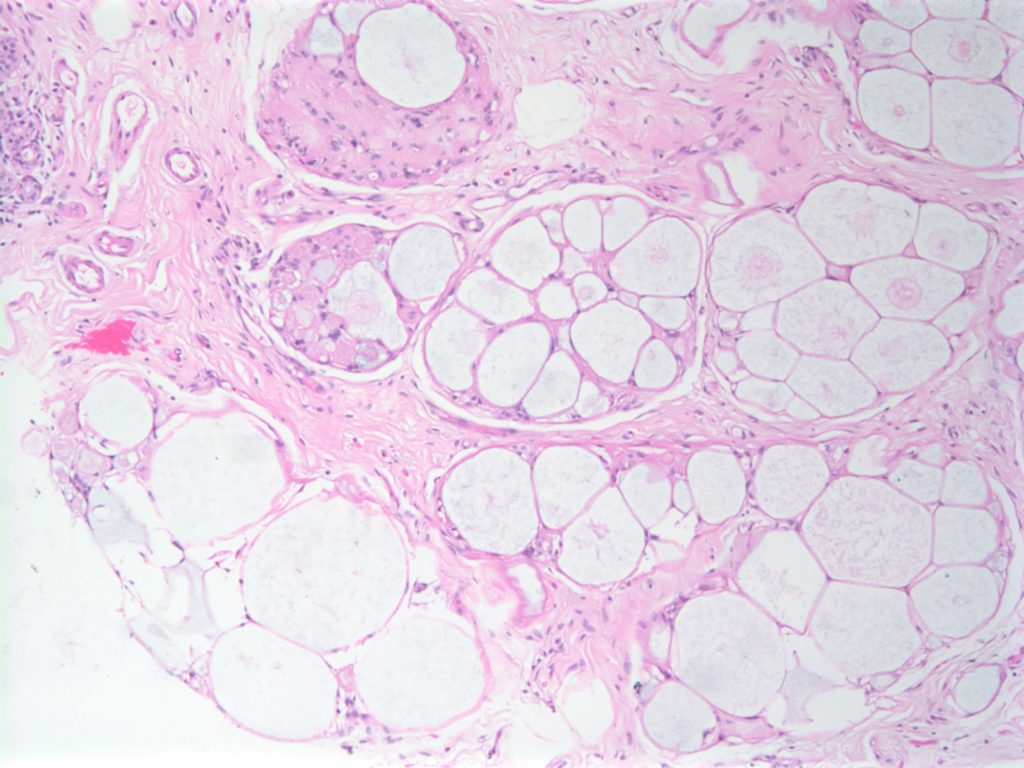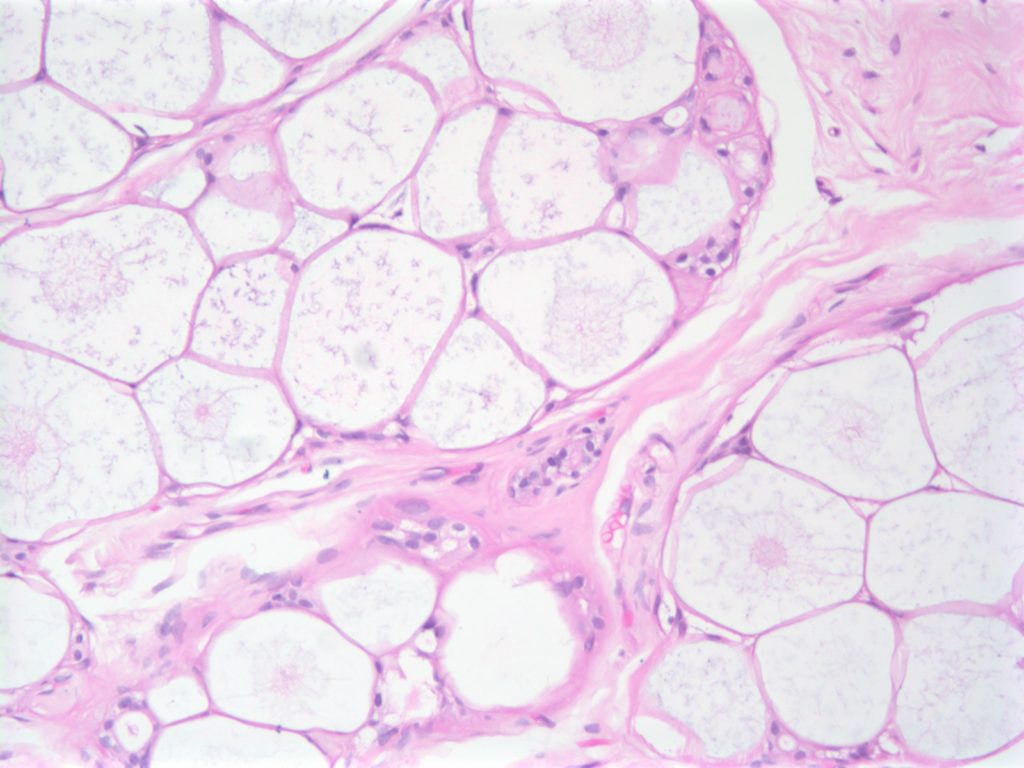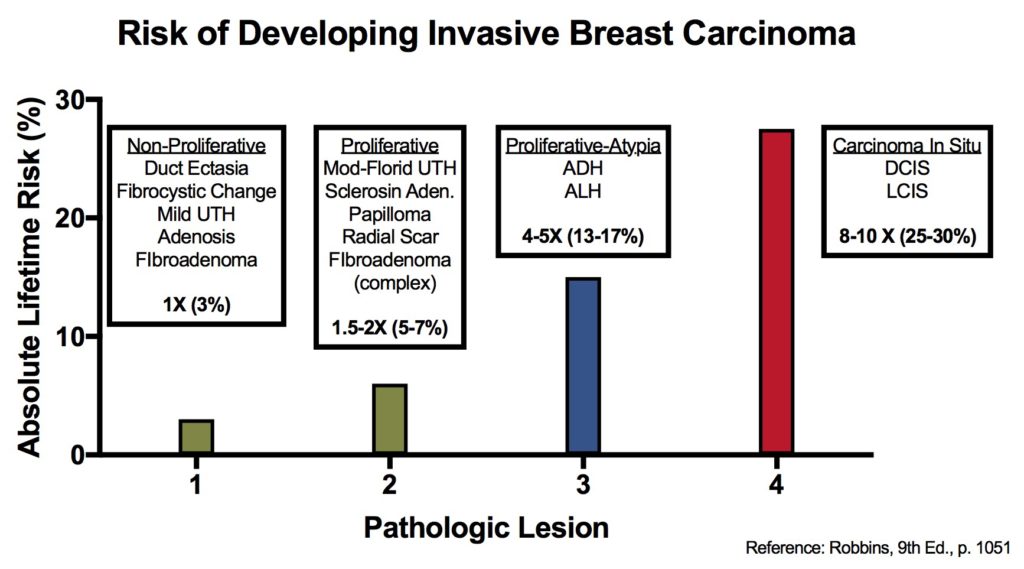Continue reading Nottingham Grading System – Breast Carcinoma
Category Archives: Breast
Bloom-Richardson Grading – Breast Carcinoma
Continue reading Bloom-Richardson Grading – Breast Carcinoma
Breast – Collagenous Spherulosis
Collagenous Spherulosis is an uncommon incidental benign finding, which can be confused with other pathologies such as DCIS, carcinoma, and adenoid cystic carcinoma of the breast.
The lesions are characterized by central mucin with epithelial cells (luminal and myoepithelial) radially arranged at the periphery.
Photomicrographs


References
Resetkova, E., et. al. “Collagenous spherulosis of breast: morphologic study of 59 cases and review of the literature.”. Am J Surg Pathol. 30 (1):207. Jan 2006. doi:10.1097/01.pas.0000179237.91515.81
Breast – Fat Necrosis
Fat necrosis may sometimes present as a palpable mass, which may raise clinical concern or distress in the patient. Approximately 1/2 of cases have a history of trauma. Fat necrosis is also a common finding in excision specimen after a preceding biopsy.
The characteristic findings of fat necrosis include mixed inflammation (neutrophils, histiocytes, etc.), fibroblastic proliferation, and liquefactive fat necrosis. Each of the component may vary in prominence. The most important thing is not to mistake fat necrosis for malignancy, and not miss an area of malignancy masked by fat necrosis (AE1/AE3 or CAM5.2 may be helpful in such situations).
Photomicrographs



References
Breast – Epithelial Proliferations
There are many features of breast disease that encompass a wide spectrum of morphologic and radiologic findings, which have a varying risk of subsequent carcinoma. Some of these entities are thought to be direct precursors to invasive carcinoma, and others just signify a component of future risk of invasive carcinoma.
Non-Atypical Lesions
- Fibrocystic Change
- Usual Type Hyperplasia (UTH)
- Sclerosing Adenosis
- Complex Sclerosing Lesion/Radial Scar
- Intraductal Papilloma
- Fibroadenoma
Miscellaneous Findings
Atypical Lesions
Breast Lesions and Risk of Developing an Invasive Carcinoma
Breast Immunohistochemsitry
Breast – IHC
There are multiple situations where immunohistochemistry can serve an important role in breast disease. These include: differentiation of lesion types (e.g. UTH vs. ADH), identifying invasion (e.g DCIS vs. DCIS with invasion), and predictive/prognostic information (e.g. ER/PR/HER-2).
Breast Lesions and Risk of Developing an Invasive Carcinoma
The following table and figure illustrate the risk of developing an invasive breast carcinoma based on the type of lesions previously identified. This information does not take into consideration other factors such as race and family history (complicated topic).
Relative and Absolute Risk of Invasive Breast Carcinoma
|
Relative
Risk
|
Absolute
Risk
(lifetime)
|
Breast
Lesion
|
|
1
|
3%
|
|
|
1.5 – 2
|
5-7%
|
|
|
4 – 5
|
13-17%
|
|
|
8 – 10
|
25-30%
|

References
Kumar, Vinay, Abul K. Abbas, and Jon C. Aster. Robbins and Cotran Pathologic Basis of Disease. Ninth edition. Philadelphia, PA: Elsevier/Saunders, 2015.
Breast
Non-Neoplastic/Pre-Neoplastic Disorders
- General
- Developmental
- Inflammatory
- Epithelial Proliferations
- Breast Lesions and Risk of Carcinoma
Breast – Atypical Lobular Hyperplasia (ALH)
Breast lesions and risk of developing an invasive carcinoma

References
Kumar, Vinay, Abul K. Abbas, and Jon C. Aster. Robbins and Cotran Pathologic Basis of Disease. Ninth edition. Philadelphia, PA: Elsevier/Saunders, 2015. p. 1050-1051
Breast – Intraductal Papilloma
Breast lesions and risk of developing an invasive carcinoma

Reference
Kumar, Vinay, Abul K. Abbas, and Jon C. Aster. Robbins and Cotran Pathologic Basis of Disease. Ninth edition. Philadelphia, PA: Elsevier/Saunders, 2015. p. 1048-1051
